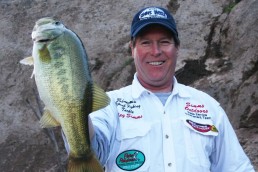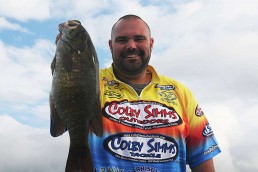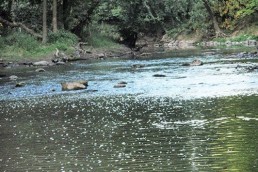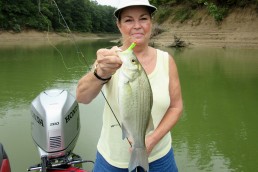Warming Water and Bigger Strike Zones Key Midsummer Bassin’
SHARE THIS POST
In the middle of summer after the hot weather has set in, bass fishing can be fantastic. But it can also be tough. Warm waters mean an increase in the metabolism of bass, which can lead to more frequent feeding activity. Additionally, warm waters allow anglers to move faster and burn lures, not only directly by a bass, but also through the edges of their larger strike zones, places far enough away that they might not chase down and attack prey in cooler waters at other times of year.
Good times and bad
A cold front, high fishing pressure or a variety of other factors can slow the bite down significantly. Anglers have to switch gears to get back on the bite again. Additionally, when water temperatures climb far outside the optimal temperature range of the bass, this can present additional problems to overcome. Warm water is usually awesome and hot water can be great, but extremely hot water can become a bad thing, fast.
Active bass
When bass are aggressive, anglers can choose between lots of different lure options and methods and can often use their favorites to score. Still, the most efficient method is usually going to be a faster approach. Standard-sized offerings are usually best, unless the water has an abundance of small or large prey at that time. Picking a lure that can be fished fast, such as a spinnerbait, lipless crankbait or buzzbait, is a top option. Swim jigs paired with paddle-tail swimbaits and some blade baits can be good choices as well. Another is a chatterbait or other shaker jig, especially when paired with a swimbait tail. While exceptions exist, fishing at and near the surface is often best for active summer bass that are aggressively feeding.
Inactive bass
When bass become inactive in summer, it sometimes takes some coaxing to get them to bite. Slowing down and finessing plastics and jigs is sometimes necessary. Lipped crankbaits can be great in tough conditions when fished slowly, and the same can be said for slow-rolling a spinnerbait. Inactive bass are less likely to strike surface lures, while fishing lures in the water column or along the bottom tend to be more effective in these extreme situations. Slow vertical jigging with spoons works too. While standard-sized offerings can produce, be ready to quickly switch to smaller- or larger-sized lures if the bite doesn’t pick up. Likewise, while slower retrieve speeds are best, if the standard and slow speeds don’t produce, be ready to radically increase the speed, even faster than the higher-speed approach common when summer bass are active. Burning lures at high speeds can play on the instincts of bass and cause them to attack lures when they normally wouldn’t with slower retrieves.
Are you enjoying this post?
You can be among the first to get the latest info on where to go, what to use and how to use it!
Tackle selection
Choosing the right equipment is critical to coaxing and landing fish. When fishing full time for a living and spending tremendous time on the water you begin to realize how much little things make a difference. Whether it’s guiding charter trips, competing in tournaments, filming network shows, fishing for magazine photo shoots or attending media events, many long days on the water cause lots of details to stand out. Select quality reels that allow for long casts with smooth drag systems that aid in landing trophy-caliber bass. Many of the newer reels out there offer more line capacity in a smaller package. Line capacity is important, and we just love using the new small and lightweight reels that hold enough line; they’re easier to fish with all day long. And even for anglers who don’t fish as a job, they will also appreciate these kinds of reels after a weeklong fishing vacation, a weekend trip or even just one day on the water.
This is even truer with baitcasting gear. Palming a new, compact, low-profile baitcaster significantly reduces hand, wrist, arm, shoulder and back fatigue, helping you stay focused so you can perform better and catch more fish. We’ve recently started using a new brand of bass rods. The Vexan bass rods from Tackle Industries are awesome. These are light and fast rods in great actions, yet they’re extremely strong and durable. While we use these mostly for bass fishing, muskies, catfish, stripers and other big game species are no match for them and they handle abuse that most bass rods don’t. Like choosing new compact reels, comfort is a factor with rods as well, and these fish great. The rods also have solid reel seats, comfortable non-slip foam grips, split-grip handles and actions that make all-day casting and retrieving a breeze. We use all types of lines and many are versatile and can be used with different presentations. Line type selection depends more on fish size and cover than anything, with a few exceptions. We always use monofilament between 10- and 20-pound-test for topwaters because it tends to float and stay on the surface. Fluorocarbon from 8- to 25-pound-test is the top choice in clear waters where bass are pressured and spooky. Braids from around 30- to 65-pound-test work best in heavy vegetation where lures have to be ripped through.
Colby Simms is a professional fisherman, media personality, guide and owner of Colby Simms Outdoors Group. He runs a guide service, sells tackle and books on guided fishing and hunting trips. Contact: colbysimmsoutdoors@hotmail.com, 618-521-0526, 573-358-5948 or colbysimmsoutdoors.com.
MWO
SHARE THIS POST
Did you enjoy this post?
You can be among the first to get the latest info on where to go, what to use and how to use it!
Colby Simms
Colby Simms is a professional fisherman, media personality, guide and owner of Colby Simms Outdoors Group. He runs a guide service booking guided fishing and hunting trips, and sells tackle. Contact him at colbysimmsoutdoors@hotmail.com, Facebook @ColbySimmsOutdoors and @ColbySimmsSportFishingPro, or 618-521-0526 or 573-358-5948.




